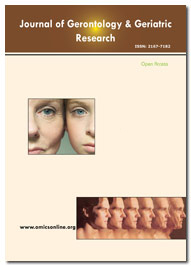Indexé dans
- Ouvrir la porte J
- Genamics JournalSeek
- SécuritéLit
- RechercheRef
- Université Hamdard
- EBSCO AZ
- OCLC - WorldCat
- Publions
- Fondation genevoise pour la formation et la recherche médicales
- Pub européen
- Google Scholar
Liens utiles
Partager cette page
Dépliant de journal

Revues en libre accès
- Agriculture et aquaculture
- Alimentation et nutrition
- Biochimie
- Bioinformatique et biologie des systèmes
- Business & Management
- Chimie
- Génétique et biologie moléculaire
- Immunologie & Microbiologie
- Ingénierie
- La science des matériaux
- Neurosciences & Psychologie
- Science générale
- Sciences cliniques
- Sciences environnementales
- Sciences médicales
- Sciences pharmaceutiques
- Sciences vétérinaires
- Soins infirmiers et soins de santé
Abstrait
Zumba®!: An Antidote for Uncontrolled Weight Gain Associated with Polycystic Ovarian Syndrome with Subclinical Hypothyroidism?
Nnamdi Orakpo, Ph.D and James H. Swan Ph.D
Background: Polycystic Ovarian Syndrome (PCOS), a variant of anovulatory cycles, presents with an estrogen dominance with low progesterone, sometimes leading to Subclinical hypothyroidism (SH). This case study is about a 31 year old woman with the inability to conceive, who was diagnosed with PCOS. Since her diagnosis 12 years ago, she has been to many physicians who have been unable to successfully manage her “mystery case”. She currently has all the symptoms of PCOS with weight gain, hirsutism, hyperlipidemia, and Type II Diabetes Mellitus, for which she took Metformin, and could not bear the side effects. Recently, she discovered a goiter in her neck. This case study examines the etiology of PCOS, leading to SH, and the battle with increasing weight loss success. Methods: Laboratory data and logs of weight changes of the subject between years 2007-2013 was utilized. After being diagnosed with PCOS, the patient was prescribed the following regimen: 1) diet, 2) family support 3) OCP, Ca2+, Metformin, Vitamins, fat burners, and colon cleansers 4) moderate- vigorous Physical Activity-Zumba. The subject was reevaluated every three months with a physical exam and hormone lab tests; ELISA for Anti- peroxidase was also performed. Results: Physical exam revealed a goitre, but most recent ELISA test ruled out Hashimoto’s (anti-microsomal antibodies). Estradiol=1.8 pg/mL (N=1.3-2.3), Progesterone=11 pg/mL (N=75-270), Pg/E2 Ratio=6 (Optimal=100-500), Testosterone=17 pg/mL (N=16-55), DHEA Sulfate=287 (N=39-232), Morning Cortisol=3.8 ng/mL (N=3.7-9.5), LDL=118 (N=0-99), Cholesterol=233 (N=0-199), Free T3=2.5 pg/mL (N=2.3-4.2), Free T4=0.91 (N=0.73-1.95), Thyroid peroxidase Ab<1 IU/mL (N<9 IU/mL), and Ultrasensitive TSH=2.810 IU/mL (N=0.500-4.7). The patient lost 83 pounds between 2008-2010 with the original treatment regimen that included 14 prescription drugs. After intervention in 2012 the subject had a 3% decrease in BMI. Conclusion: The study concluded that weight loss success was achieved through the following: 1) moderatevigorous physical activity: High-Impact Zumba, spousal, physician, and family support; self-motivation; selfempowerment; and optimism.